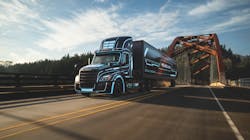Freightliner Electric Innovation, CX Fleets log a million miles
Daimler Trucks North America (DTNA) revealed that its Freightliner battery-electric Innovation and Customer Experience (CX) Fleets have reached one million miles of real-world usage, with fleets operating across the West Coast and Canada. With the opening of order boards for the eCascadia and eM2 earlier this year, DTNA is already seeing high demand for its electric trucks.
“We have reached a tipping point in our electrification journey,” Rakesh Aneja, VP and chief of eMobility at DTNA, said. “After a million miles of learning in close collaboration with our valued customers, we are ready to move from prototype to scale—from tens of customer experience trucks to hundreds of production units. We remain committed to continuously improve our vehicle technology, reduce cost of ownership, and support infrastructure development—the required trifecta for a successful electrification transformation.”
Real-world electric miles
Comprising more than 40 battery-electric Freightliner eCascadias and eM2s, the Freightliner Electric Innovation and CX Fleets have transformed the testing process by putting trucks into the hands of almost 50 customers to accumulate experience while performing real work, in real fleets, and real commercial vehicle applications.
Freightliner’s Electric Innovation Fleet began in 2018 with electric trucks running drayage and regional haul routes in Southern California with Penske and NFI. The CX Fleet followed in 2020 with additional vehicles, which have been rotating between various customers in both the U.S. and Canada for the past year. Both fleets have now hit one million accumulated testing miles.
Participation in the Innovation and CX Fleets and being an active part of DTNA’s Electric Vehicle (EV) Council has provided those companies a chance to test integration of battery electric trucks into their own fleets and to share their learnings and experiences openly amongst all customers. The fleets are supported by the South Coast Air Quality Management District (South Coast AQMD) which focuses on improving air quality in the South Coast Basin of Southern California and partially funded the project.
The nation’s leading fleets have all contributed to the development of Freightliner’s electric Class 8 and Classes 6-7 trucks, including Penske Truck Leasing, NFI, Hub Group, Knight-Swift, Schneider, XPO, Ryder, J.B. Hunt, and UPS, along with specialized fleets such as Loblaw Companies Limited, Sysco, Southern California Edison, Fastenal, Temco Logistics, Bison Transport, Core-Mark, Costco Wholesalers, Iron Mountain Inc., KeHe Distributors, Mondelez International Inc., U.S. Foods, and Velocity Truck Rental & Leasing.
What DTNA has learned so far
From collecting driver feedback, comparing the relative impact of driver behavior, temperature, weather, and weight between multiple fleets and duty cycle, to assessing wear, testing charging equipment behavior, and readying the service network, DTNA has gained a variety of operational data that will apply to the production vehicles to be delivered to customers in late 2022.
“Our rigorous testing has revealed powertrain and auxiliary components, including HVAC, thermal management and low voltage electrical, are high performing and more than up to the job,” Andreas Juretzka, head of electric mobility product development at DTNA, said. “One lesson stands out in particular: the importance of regenerative braking to maximize range. Across the pilots, the average recuperation ratio was 20-25%, with some drivers achieving even up to 30%.”
According to the company, testing electric trucks in real conditions with real fleets has validated and reaffirmed many of the expected benefits of electric trucking from reduced driver fatigue to minimal noise and vibration.
